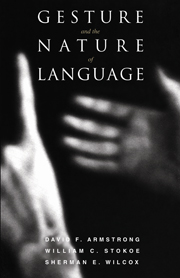Book contents
- Frontmatter
- Contents
- Acknowledgments
- Introduction: language from the body
- 1 The universe of gesture
- 2 The nature of gesture
- 3 Are signed and spoken languages differently organized?
- 4 Is language modular?
- 5 Do we have a genetically programmed drive to acquire language?
- 6 Language from the body politic
- 7 The origin of syntax: gesture as name and relation
- 8 Language from the body: an evolutionary perspective
- References
- Author index
- Subject index
1 - The universe of gesture
Published online by Cambridge University Press: 05 June 2012
- Frontmatter
- Contents
- Acknowledgments
- Introduction: language from the body
- 1 The universe of gesture
- 2 The nature of gesture
- 3 Are signed and spoken languages differently organized?
- 4 Is language modular?
- 5 Do we have a genetically programmed drive to acquire language?
- 6 Language from the body politic
- 7 The origin of syntax: gesture as name and relation
- 8 Language from the body: an evolutionary perspective
- References
- Author index
- Subject index
Summary
For if we are to do the biology of language at all, it will have to be done by tracing language to its roots in the anatomy, physiology, and social environment of its users. Only in this way can we hope to arrive at an account of language perception and production fitted to animals rather than machines.
Michael Studdert-Kennedy, Perceiving phonetic eventsSIGNED AND SPOKEN LANGUAGES
Linguistic, psycholinguistic, and sociolinguistic research on American Sign Language (ASL) over the past three decades has established without question that ASL is a natural human language. Studies of several other indigenous signed languages have led to the same conclusion: primary sign languages, those used (mainly) by deaf people, are fully developed human languages more or less independent of the spoken languages of the linguistic communities in the same region. One of our purposes here will be to explore just how independent of each other these signed and spoken languages are. Several questions occur to us.
First, what is the relationship between spoken and signed languages? Are signed languages merely analogues of spoken languages, the linguistic equivalent of the bat's wing (evolved quite differently from the bird's wing)? Or are they true homologues, biologically related, as the human lung is to the swim bladder of fish? One objective of this book is to frame the study of signed languages in terms that will lead to answering the question of relationship.
- Type
- Chapter
- Information
- Gesture and the Nature of Language , pp. 5 - 26Publisher: Cambridge University PressPrint publication year: 1995



